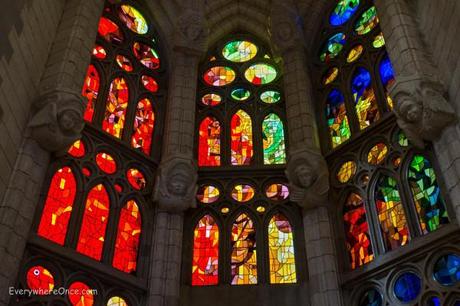
The facade of Gaudi’s La Sagrada Familia
Barcelona wouldn’t be as colorful without Antoni Gaudí. Hailed as a visionary by some and a madman by others, the innovative architect left his mark across the city, from lampposts in the Plaza Real–one of his earliest commissions–to his last, still-unfinished work, the Basilica of the Sagrada Familia.
Gaudí threw classic architectural rules out the window. At the forefront of the 19th-century Modernisme style, he drew inspiration from nature and organic forms. He combined vibrant colors, curved lines, and Moorish and Gothic elements with a healthy dose of creativity. Trees, flowers, fruit, and seashells fired his imagination and so did more dramatic images like dragons and skulls.
It’s nearly impossible to visit Barcelona and not at least learn Gaudí’s name. Crack open a guidebook, and his buildings top the lists of sights to see. Sagrada Familia is ranked #1 of 320 attractions on TripAdvisor. The thought of contending with the crowds clamoring to see Gaudí’s creations nearly dissuaded us from seeking them out, particularly stories of hours-long lines to enter the Sagrada Familia.
But the thought of not seeing the fanciful handiwork of Barcelona’s most famous son was worse, and so we selected a few sights to visit. And we’re glad we did. More than a century later, the buildings that emerged from Gaudí’s mind still seem refreshingly unique and cutting-edge.
La Sagrada Familia

The basilica’s “warped Gothic” exterior, which looks like a sand castle melting in the sun, contrasts starkly with the sleek, cool, vibrant interior. Columns modeled on trees stretch upwards toward a wave-shaped, domed ceiling, while stained glass windows, each flaunting a different hue, infuse the cavernous space with fiery color. Devoid of the common biblical scenes depicted in stained glass windows, the colors blaze as gloriously as a peacock’s finery. If American glass artist Dale Chihuly decorated a church, I imagine it would look something like this.

Gaudí spent the last forty years of his life working on the Sagrada Familia, making the hour we spent queuing to see it seem trivial in comparison. He was so devoted to the project that he moved into his workshop on the premises to be closer at hand. The basilica was still in its fledgling stages when he died in 1926, after being hit by a tram while strolling through Barcelona. No cab driver would take him to the hospital, believing the shabbily dressed man wouldn’t be able to pay the fare. Crucial time was lost getting him medical attention, and he died two days later.

Gaudí’s influence on the basilica’s construction didn’t end with his death. Architects have continued working on it using models he made as a guide. The projected completion date is 2026, the centennial of the architect’s passing. Fittingly, Gaudí’s final resting place is the crypt in the Sagrada Familia.
Parc Guell

Before Gaudí decamped to the Sagrada Famlia, he lived in a whimsical-looking house in the Parc Guell. His former abode is now a museum, part of this wonderland garden complex situated on high ground overlooking Barcelona.
The Parc Guell originated as a housing development for the city’s well-to-do before eventually being converted into a public space. Gaudí’s creativity is on full, magnificent display here—a mosaic-tiled courtyard, a Roman-inspired columned hall, a grotto-lined walkway and a creature guarding the entrance (either a lizard or a dragon, depending on your interpretation).

The best part: we arrived around opening time on a Sunday morning and found no queue at the ticket booth.
Casa Batlló

Gaudi’s Casa Battló (right) contrasts with Barcelona’s more traditional style (left)
The cardinal rule of sightseeing is to arrive early. We failed to follow our own advice, and by the time we got to Casa Batlló, mid-morning on a weekday, the swarms outside the building made us shudder at the thought of what the interior was probably like. Good thing there is plenty to admire from the sidewalk.
A prestigious businessman hired Gaudí to transform a drab apartment building into something audacious and eye-catching. What emerged from the architect’s mind locals dubbed the “House of Bones.” Balconies resembling skulls adorn a wavy-shaped façade covered with broken pieces of ceramic. Topping off the building is a blue- and green-tiled roof that resembles a dragon’s scaly, flexing back, said to represent St. George’s legendary conquest.
Is Gaudí’s Barcelona gaudy or gorgeous? That’s the beauty of it. It’s in the eye of the beholder.

